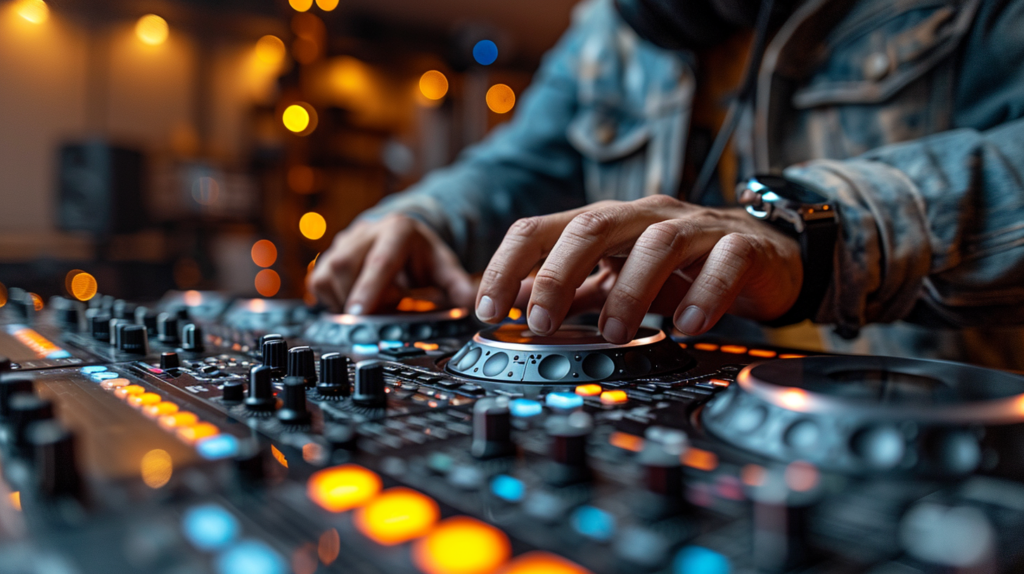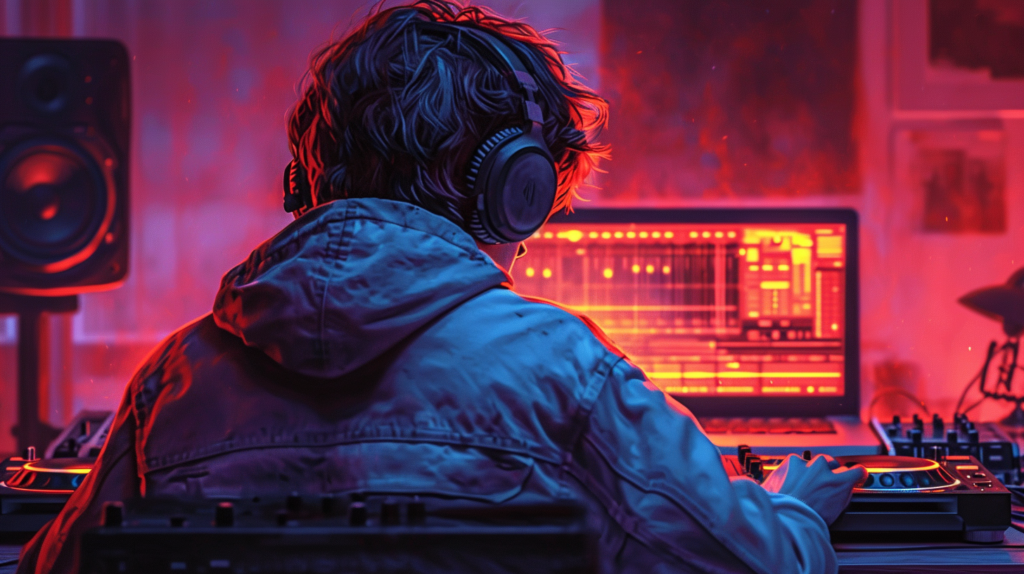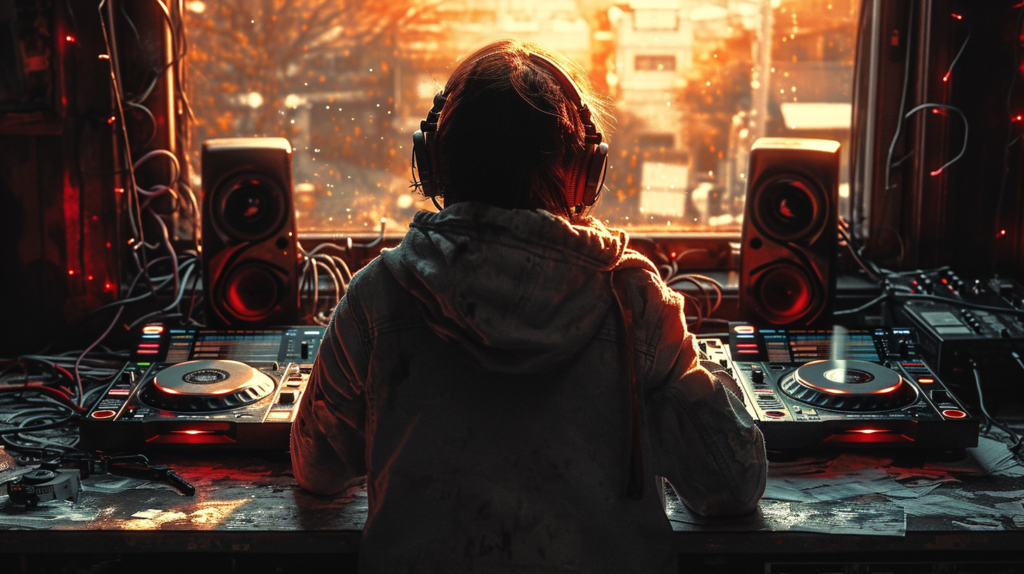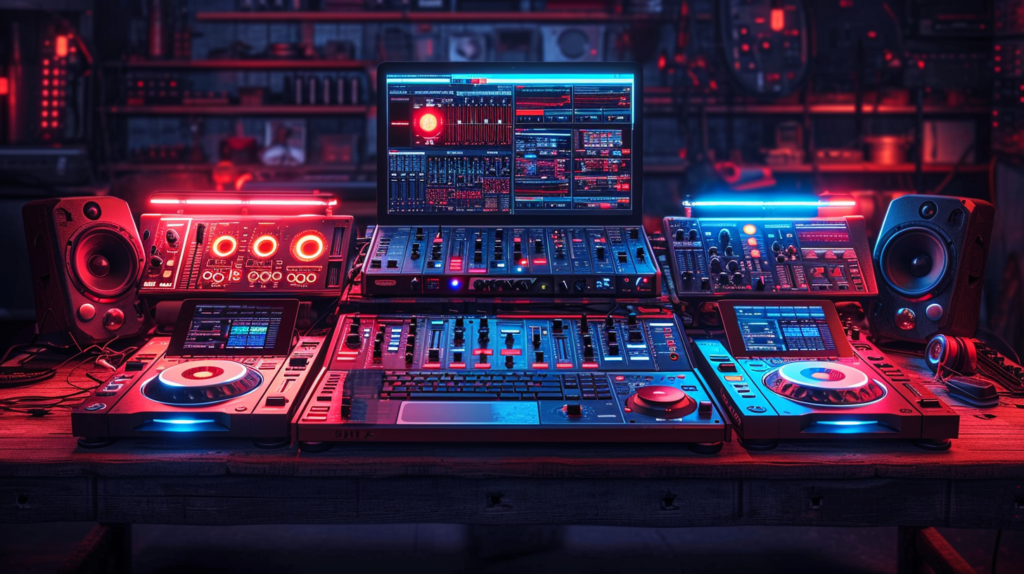With just a compact DJ controller and quality headphones, bedroom DJ hopefuls can start mixing beats without costly speakers or annoying neighbors.
While professional sound systems remain an essential element of public performances, amateur DJs can leverage headphone-integrated controllers to practice the craft at home in isolation.
From beatmatching fundamentals to creative transitions, let’s explore what mix capabilities headphones unlock alongside limitations speakers still provide.
Can You DJ Without Speakers?

Yes, you absolutely can DJ using only a controller connected to headphones. Most modern DJ controllers include a built-in audio interface that allows you to route the master mix audio directly into your headphones without the need for external speakers. This makes it easy for aspiring DJs to learn mixing fundamentals like beatmatching and transitioning between tracks without disturbing others. However, there are still some significant benefits speakers provide that headphones cannot replicate fully when judging more advanced techniques. Let’s explore those possibilities and limitations in more depth below.
Why You Might Want to Use a Controller Without Speakers

There are several good reasons why you may want to use your DJ controller without connecting it to external speakers. For many beginner or amateur DJs, the ability to plug in a controller and start mixing tracks using just a set of headphones is extremely appealing for a few key reasons.
Firstly, practicing DJing using just a controller and headphones allows you to hone your mixing skills without disturbing housemates, family, or neighbors with loud music. As DJing requires a lot of learning by trial and error, new DJs inevitably have to work through some messy early mixes and imperfect beatmatching attempts. By containing the audio to headphones, an aspiring, still-learning DJ can avoid annoying or alienating people nearby while getting the reps in needed to improve.
Another great reason to use a DJ controller without speakers is to test drive the hardware and software before you invest in additional equipment. If you purchase an all-in-one controller, it will likely come with DJ software and everything you need to mix using headphones right out of the box. This offers a great way to experiment with DJing on a budget without immediately having to drop hundreds of dollars on speakers, amplifiers, or other gear.
Finally, the ability to learn on just a controller and headphones lowers the barrier for people to enter DJing and gives the most basic tools needed to learn techniques. Rather than having to lay out large sums for equipment from the start, new DJs can access training on beatmatching, mixing in key, using effects, song structure analysis and more by just purchasing an entry-level controller and headphones to start. The learning can commence without speakers as an added cost.
What You Can Do With a Controller and Headphones

While serious, professional-grade performances and mixes will require powerful speakers, there is still a good amount a DJ can practice and simulate using just a controller, DJ software, and a decent pair of headphones designed specifically for DJing. Learning the ropes of DJing has never been more accessible and affordable.
Most modern DJ controllers, which provide jog wheels, pads, faders and knobs to manipulate music digitally, will connect to your computer via USB and then output audio through a standard headphone jack. Top DJ software platforms like Virtual DJ, Traktor, Serato, and Rekordbox support audio output direct to headphones so a user can preview music tracks, experiment with them, and attempt to mix them together entirely by listening on their headphones.
While listeners won’t get to enjoy your headphone-only mixing masterpiece, having quality headphones at least allows the DJ to queue up tracks, adjust EQs and effects, set cue points, and practice the intricate work of matching up the beats per minute of two tracks to transition smoothly between them. This fundamental skill of beatmatching may not sound incredibly exciting, but it is an absolute core competency required of any working DJ. And it can be practiced ad infinitum without speakers ever entering the picture.
Tips for Practicing DJing With Just Headphones

While speakers are not entirely necessary for learning and practicing DJ techniques, that doesn’t mean headphones are interchangeable either. There are some specific gear and mixing considerations to factor in if you plan to spend significant time honing your abilities with just a controller plugged into your computer and headphones covering your ears.
First, if you don’t own already, invest in a good pair of over-the-ear, closed-back headphones specifically designed for DJing applications. Models like the Sony MDR-7506, Audio-Technica ATH-M50x, Pioneer HDJ series, or Sennheiser HD 25 offer the audio quality, noise isolation, and loud monitoring volume essential to analyze your mixes and catch little sync issues or other unintentional drifts between tracks. Consumer headphones may work in a pinch, but rarely provide the clarity needed for intensive, critical DJ listening.
With quality headphones secured, also be sure to turn up your volume higher than you would for casual music listening. Trying to discern intricate transitions between songs at modest volumes will significantly increase the difficulty. Listen at volumes akin to being on a loud dancefloor to fully comprehend exactly how each layer of the mix is blending and sounding. This may require adjusting software or hardware gains to maximize headphone output without distortion or damage to your ears.
When focused on practicing beatmatching tracks specifically, pay extra attention to the waveforms on your DJ software screen showing the time analysis of each song. Use these visual cues along with the audio coming through your phones to correctly sync tempos. Rely more heavily on sight here since headphones alone may not provide enough context to get mixes perfectly in time. Master the ability to align kicks, snares, vocals, and other track elements guided by those waveforms.
Since overzealous application of effects like echo, reverb and flanger can quickly muddy a mix to incoherence, show some restraint until you can reliably assess how those enhancements translate from headphones to a proper sound system. Judicious EQ adjustments and subtle fader transitions should be the primary tools utilized when mixing with headphones alone.
And finally, when cuing tracks up do so using your headphones rather than the master speakers which won’t exist in this case. Most DJ gear provides a Split or Mix control to choose whether to send the cue audio directly to your headphones or incorporate both cue and master signal. For headphone-only mixing, splitting to headphone-exclusive cueing prevents you having to simulate fader and EQ changes rather than implement them live.
Limitations of Mixing Just on Headphones

As hopefully the above tips have illuminated, while DJing without external speakers poses some challenges, those can mostly be accounted for with the right headphone gear and adjusted mixing approaches tailored specifically to an audio feed limited just to your ears in isolation.
However, even with the most top-of-the-line headphones on the planet, true on-speaker sound quality can never fully be replicated in earbuds alone. As such, expect that your complex, meticulously-crafted DJ mixes may sound slightly different played over an actual club or party sound system versus headphones. Some of the stereo panning sweeps, airy effects, and booming low end may translate differently outside of a closed headphone environment.
With the lack of physical speaker sensation to inform your mixing instincts, also recognize it becomes exponentially harder to catch more subtle cases of tracks falling slightly out of sync without large waveforms to stare at. Avoiding even occasional lapses in tight beatmatching comes far easier with speaker reference than headphones alone which may forgivingly mask some drifting that would be apparent on a proper club system.
The type of speakers utilized will also impact how well headphones approximate the full experience. For instance, mixing intricate ambient or heavy bass-focused electronic music may show greater disparity of sound versus mixing more center-focused hip hop instrumentals. Headphones boost and isolate center channel audio like vocals in ways speakers distribute across left/right balance.
So in situations where music relies more heavily on intricate stereo sound design versus rapped vocals, expect headphone previews to potentially overlook elements of a mix that would shine or clash over big system subwoofers. Essentially, headphones lie differently depending on the frequency makeup teased by them which speakers convey full-range.
Finally, some of DJing’s excitement and fulfillment comes from peaking crowd reaction in the moment. Dropping a massive bass drop to erupting cheers or transitioning smoothly out of one genre into another judging by audience vibe inherently involves adapting mixes based on real-time speaker output assessments. Just you and two earbuds severely limits reading the dancefloor compared to embracing their collective immersion alongside your monitors.
When It’s Time to Add Speakers to Your DJ Setup

Considering both the opportunities and limitations outlined above for controller-and-headphone based DJ practice, you’ll inevitably reach a point where having actual speakers to transmit sound becomes necessary. Once fundamental techniques feel established from ample headphone-focused hours spent mixing, means it may be time to start considering some speaker additions.
The first step is determining use context to select suitable system hardware. Bedroom hobby DJs can likely start very basic with amplified computer speakers, a Bluetooth speaker like JBL’s party offerings, or compact active studio monitors from brands like KRK. Be warned even entry-level studio monitors provide a huge upgrade from headphones so a little power goes a long way.
For gigging DJs playing events, standalone all-in-one PA speakers from Electro Voice, Mackie or Yamaha provide an easy plug-and-play option to handle the essential speaker duties. Most accept XLR, RCA or quarter-inch inputs to hook directly up to a controller just like headphones would. No separate amps or processing required!
And finally, for full-blown club installs with tremendous bass demands and very loud monitoring needs across a large space, look into the professional speaker systems offered by Funktion One, Void, D&B, and L’Acoustics. At this tier though, expect to require serious acoustic treatment and noise management to appease the neighbors!
Whether basic computer speakers or a festival-worthy system, the key when adding speakers is focusing attention on how headphone mixes translate over the real, acoustic air. Pay careful attention if elements feel more/less pronounced on speakers and make EQ, level and effects tweaks to output more balanced, ear-pleasing result.
This translation might take some trial and error to get right depending on speaker frequency response, positioning and other environmental factors so don’t get discouraged. Just like learning on headphones alone, be prepared to put in some time getting familiar with how your meticulously-crafted mixes sound pouring from a physical sound system rather than sealed inside your head! The speaker dimension opens up exciting new possibilities but requires further adaptation too.
Stay patient through this learn adjustment process and before you know it, speakers will become like another intuitive instrument at your mixing fingertips just like headphones have for practicing over time or alone. Gear up those speaker wires and get ready to feel some actual, face-melting bass vibes resonating from your DJ handiwork!
Conclusion
In conclusion, while DJing without speakers poses some distinct challenges, the barriers to entry are lower than ever thanks to headphone-enabled controllers. Aspiring DJs can start learning the craft sans speakers, then gradually integrate monitor additions once skills progress. Expect a bit of a transition when adding speakers, but with practice mixes ultimately translate. So grab those cans, cue up some banging beats, and let the seamless blending commence!
